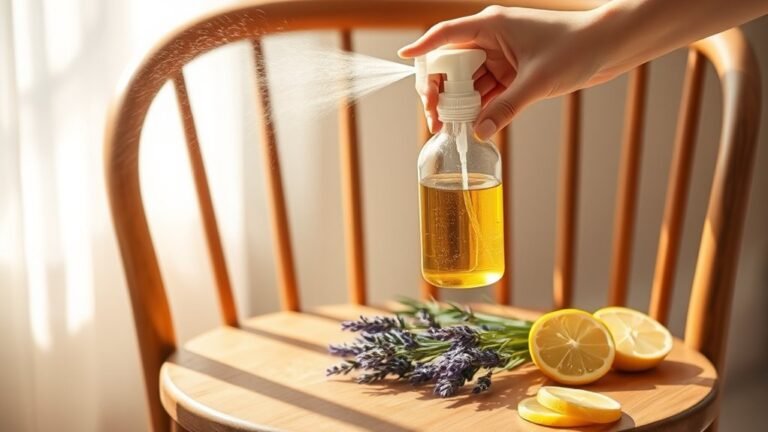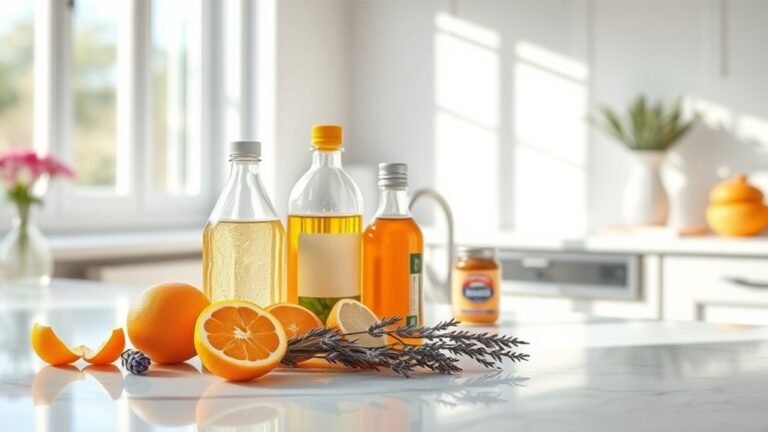How to Clean Your Stains Safely
To clean stains safely, start by identifying the stain type—oil-based, protein, or dye—to pick an appropriate cleaner. Use gentle, fabric-safe agents like vinegar or baking soda for common stains, and blot excess residue right away without scrubbing. Always test cleaners on hidden fabric areas, avoid mixing chemicals, and rinse with cold water. These steps protect your clothes and upholstery from damage. Following this approach helps you tackle stains effectively while preserving your fabrics’ quality.
Identifying Different Types of Stains

How can you effectively tackle a stain if you don’t know what type it is? Understanding stain characteristics is your first step toward freedom from stubborn marks. Stain classification involves identifying the source—whether oil-based, protein-based, tannin, or dye stains—since each demands a unique approach. Observe the stain’s texture, color, and how it reacts to water. For example, oil stains feel greasy and repel water, whereas protein stains may appear dull and dissolve in cold water. By methodically analyzing these features, you gain clarity on what you’re dealing with, enabling you to act confidently. This precise knowledge liberates you from guesswork, ensuring you treat stains effectively without damaging your fabrics or surfaces. Mastering stain classification empowers you to reclaim control over your cleaning process.
Choosing the Right Cleaning Agent
Once you’ve identified the type of stain you’re facing, selecting the appropriate cleaning agent becomes a straightforward task. For organic stains like food or sweat, natural cleaners such as vinegar or baking soda can be effective and gentle on fabrics. You’ll appreciate their eco-friendly nature and minimal chemical residue. However, for tougher stains like ink or grease, commercial products often provide stronger, targeted solutions. Always check labels to verify the product suits your fabric type and stain category. Avoid mixing agents, as this can cause damage or toxic fumes. By choosing your cleaning agent methodically—balancing effectiveness with safety—you maintain control over the process and protect your belongings. This thoughtful approach gives you the freedom to tackle stains confidently, without risking harm to yourself or your items.
Step-by-Step Stain Removal Techniques

Three key steps will guide you through effective stain removal: preparation, application, and rinsing. Mastering these stain removal techniques guarantees you regain control without damaging fabrics or surfaces. Start by gently blotting the stain to remove excess residue—never rub, as it spreads the stain. Next, apply the appropriate cleaning agent evenly, allowing it to penetrate. Use effective cleaning methods by letting the agent sit briefly to break down the stain. Finally, rinse thoroughly with cold water to flush out residues, preventing re-soiling.
- Blot excess stain immediately
- Choose cleaning agents matching fabric type
- Apply treatment evenly, avoid scrubbing
- Rinse completely to remove cleaning agents
Follow this methodical approach, and you’ll effectively eliminate stains while preserving your freedom to enjoy your belongings.
Preventing Damage to Fabrics and Surfaces
While mastering stain removal steps helps you tackle marks effectively, it’s equally important to protect your fabrics and surfaces from unintended damage during cleaning. Always test cleaning agents on a hidden area first to guarantee fabric protection and avoid discoloration or weakening. Use gentle, appropriate tools—soft cloths or sponges—rather than abrasive brushes that can harm fibers or surfaces. Avoid excessive moisture, which may warp or stain delicate materials. When working on surfaces, choose cleaners suited to the finish, and never mix chemicals that could cause corrosion or residue buildup. By following these precautions methodically, you maintain the integrity and appearance of your belongings. Prioritizing fabric protection and surface care not only prevents damage but also extends the life of your items, granting you the freedom to clean confidently and effectively.
Tips for Maintaining Stain-Free Clothing and Upholstery

Although no fabric is completely stain-proof, you can greatly reduce the risk of stains on your clothing and upholstery by adopting consistent habits. Staying proactive with laundry tips and upholstery care lets you enjoy your freedom without worrying about permanent damage.
No fabric is stain-proof, but consistent care can keep your clothes and upholstery looking fresh and damage-free.
Consider these essential practices:
- Address spills immediately to prevent setting.
- Use appropriate stain removers tailored to fabric types.
- Rotate cushions regularly to distribute wear evenly.
- Wash clothing according to care labels to maintain fabric integrity.
Häufig gestellte Fragen
Can Natural Remedies Be as Effective as Commercial Stain Removers?
You might find that natural alternatives can match commercial products in stain effectiveness, depending on the type of stain and fabric. While some natural remedies like vinegar or baking soda work well on common stains, they may not tackle tougher ones as efficiently. You’ll want to test these methods carefully to avoid damage. Embracing natural options gives you more control and freedom over your cleaning routine, aligning with a safer, eco-friendly approach.
How Soon Should I Treat a Stain After It Occurs?
You should take immediate action when a stain occurs to prevent it from setting. Different stain types—like protein-based or oil-based—react differently to treatments, so knowing what you’re dealing with helps. Acting quickly gives you more freedom to choose the best method without worrying about permanent damage. The sooner you address the stain, the easier it is to remove, preserving your fabric’s quality and your peace of mind.
Are There Any Stains That Should Always Be Handled by Professionals?
You should definitely leave blood stains and oil stains on delicate or valuable fabrics to professionals. Blood can set deeply and become tough to remove without damaging fibers, while oil stains often require specialized solvents. If you’re unsure or dealing with vintage or dry-clean-only items, it’s safer to avoid DIY attempts. Trusting experts guarantees your freedom from worry and preserves your items’ integrity without risking permanent damage.
Can Repeated Washing Cause Stains to Set Permanently?
Yes, repeated washing can actually cause stain setting rather than removing it. When you increase washing frequency without properly treating the stain first, the heat and agitation may embed the stain deeper into the fabric fibers, making it permanent. To avoid this, you should pretreat stains promptly and follow recommended cleaning methods. This way, you maintain your freedom to wear your clothes confidently without worrying about stubborn, set-in stains.
What Household Items Should Never Be Mixed When Cleaning Stains?
You should never mix bleach with ammonia or vinegar, as these combinations create toxic gases that pose serious health risks. Bleach dangers include producing chloramine vapors when combined with ammonia, which can irritate your lungs. Vinegar reactions with bleach release chlorine gas, harmful to your respiratory system. To keep your cleaning safe and effective, always use household items separately and in well-ventilated areas, ensuring your freedom to clean without danger.






